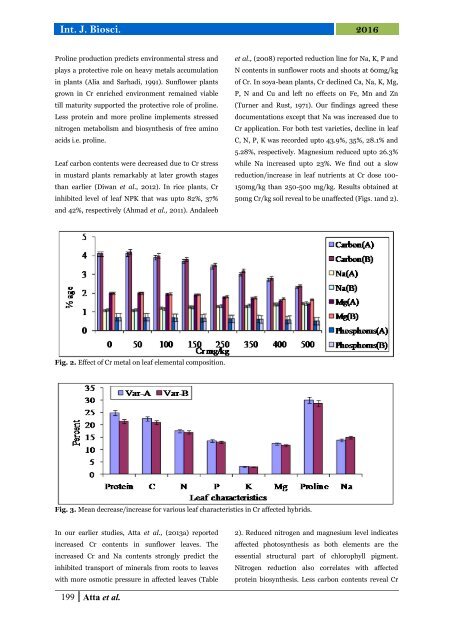Understanding leaf biochemical traits for Sunflower (Helianthus annuus L.) cultivars grown in chromium stressed environment
Abstract Environmental pollution is big curse for plants, animals and other living organisms. Being atmospheric pollutant, different levels of Cr6+ (50-500mg/kg) were applied to sunflower plants to determine its toxic effects. It was found that there was imbalanced distribution of leaf nutrients. XRF studies for various elements revealed alteration in leaf appearance due to nutritional deficiency. Leaf protein was reduced and proline increased pretentiously (p≤0.05) along Cr concentration. Viability of Cr enriched plants strongly showed the environmental protective role of proline. Present study mainly expresses chromium metal toxicity for carbon and nitrogen metabolism predicting poor growth, biomass and yield attributes in Cr treated plants.
Abstract
Environmental pollution is big curse for plants, animals and other living organisms. Being atmospheric pollutant, different levels of Cr6+ (50-500mg/kg) were applied to sunflower plants to determine its toxic effects. It was found that there was imbalanced distribution of leaf nutrients. XRF studies for various elements revealed alteration in leaf appearance due to nutritional deficiency. Leaf protein was reduced and proline increased pretentiously (p≤0.05) along Cr concentration. Viability of Cr enriched plants strongly showed the environmental protective role of proline. Present study mainly expresses chromium metal toxicity for carbon and nitrogen metabolism predicting poor growth, biomass and yield attributes in Cr treated plants.
You also want an ePaper? Increase the reach of your titles
YUMPU automatically turns print PDFs into web optimized ePapers that Google loves.
Int. J. Biosci. 2016<br />
Prol<strong>in</strong>e production predicts <strong>environment</strong>al stress and<br />
plays a protective role on heavy metals accumulation<br />
<strong>in</strong> plants (Alia and Sarhadi, 1991). <strong>Sunflower</strong> plants<br />
<strong>grown</strong> <strong>in</strong> Cr enriched <strong>environment</strong> rema<strong>in</strong>ed viable<br />
till maturity supported the protective role of prol<strong>in</strong>e.<br />
Less prote<strong>in</strong> and more prol<strong>in</strong>e implements <strong>stressed</strong><br />
nitrogen metabolism and biosynthesis of free am<strong>in</strong>o<br />
acids i.e. prol<strong>in</strong>e.<br />
Leaf carbon contents were decreased due to Cr stress<br />
<strong>in</strong> mustard plants remarkably at later growth stages<br />
than earlier (Diwan et al., 2012). In rice plants, Cr<br />
<strong>in</strong>hibited level of <strong>leaf</strong> NPK that was upto 82%, 37%<br />
and 42%, respectively (Ahmad et al., 2011). Andaleeb<br />
et al., (2008) reported reduction l<strong>in</strong>e <strong>for</strong> Na, K, P and<br />
N contents <strong>in</strong> sunflower roots and shoots at 60mg/kg<br />
of Cr. In soya-bean plants, Cr decl<strong>in</strong>ed Ca, Na, K, Mg,<br />
P, N and Cu and left no effects on Fe, Mn and Zn<br />
(Turner and Rust, 1971). Our f<strong>in</strong>d<strong>in</strong>gs agreed these<br />
documentations except that Na was <strong>in</strong>creased due to<br />
Cr application. For both test varieties, decl<strong>in</strong>e <strong>in</strong> <strong>leaf</strong><br />
C, N, P, K was recorded upto 43.9%, 35%, 28.1% and<br />
5.28%, respectively. Magnesium reduced upto 26.3%<br />
while Na <strong>in</strong>creased upto 23%. We f<strong>in</strong>d out a slow<br />
reduction/<strong>in</strong>crease <strong>in</strong> <strong>leaf</strong> nutrients at Cr dose 100-<br />
150mg/kg than 250-500 mg/kg. Results obta<strong>in</strong>ed at<br />
50mg Cr/kg soil reveal to be unaffected (Figs. 1and 2).<br />
Fig. 2. Effect of Cr metal on <strong>leaf</strong> elemental composition.<br />
Fig. 3. Mean decrease/<strong>in</strong>crease <strong>for</strong> various <strong>leaf</strong> characteristics <strong>in</strong> Cr affected hybrids.<br />
In our earlier studies, Atta et al., (2013a) reported<br />
<strong>in</strong>creased Cr contents <strong>in</strong> sunflower leaves. The<br />
<strong>in</strong>creased Cr and Na contents strongly predict the<br />
<strong>in</strong>hibited transport of m<strong>in</strong>erals from roots to leaves<br />
with more osmotic pressure <strong>in</strong> affected leaves (Table<br />
2). Reduced nitrogen and magnesium level <strong>in</strong>dicates<br />
affected photosynthesis as both elements are the<br />
essential structural part of chlorophyll pigment.<br />
Nitrogen reduction also correlates with affected<br />
prote<strong>in</strong> biosynthesis. Less carbon contents reveal Cr<br />
199 Atta et al.





![Review on: impact of seed rates and method of sowing on yield and yield related traits of Teff [Eragrostis teff (Zucc.) Trotter] | IJAAR @yumpu](https://documents.yumpu.com/000/066/025/853/c0a2f1eefa2ed71422e741fbc2b37a5fd6200cb1/6b7767675149533469736965546e4c6a4e57325054773d3d/4f6e6531383245617a537a49397878747846574858513d3d.jpg?AWSAccessKeyId=AKIAICNEWSPSEKTJ5M3Q&Expires=1714813200&Signature=Mb68zQ5AxbVCrRDlqOOiJsp44%2BY%3D)












